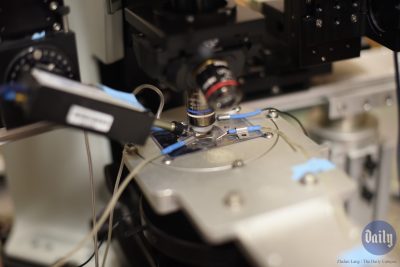
Much of the work in my laboratory is presently focused on KCNQ channels, a potassium channel family implicated in multiple neonatal epileptic encephalopathy disorders. A key objective of this work is to understand the role of these channels in the normal brain, and the impact epilepsy-associated mutations have on neuronal physiology. We also use KCNQ channels as a model to understand (i) why both loss-of-function and gain-of-function potassium channel mutations can lead to seizures, (ii) how the function of the same potassium channels can be cell-type and brain region dependent, and (iii) what types of regulatory mechanisms are used by the brain to control potassium channel activity.
Function of KCNQ channels in the normal brain
Role of KCNQ2/3 channels in cortical interneurons
We are defining the role of KCNQ2/3 channels in interneuron excitability and their contribution to the Excitation/Inhibition (E/I) balance in the cortex and hippocampus. Previous research on the function of KCNQ channels in vivo nearly exclusively focused on excitatory neurons, but in fact these channels are also expressed by inhibitory interneurons. Insight regarding the function of KCNQ channels in interneurons has become critical as some newly identified epilepsy-associated KCNQ2/3 mutations have a gain-of-function effect on channel activity, and such mutations may lead to seizures through diminished inhibitory neuron activity. For our studies, we have generated new mouse lines in which either Kcnq2 or Kcnq3 is specifically ablated in parvalbumin (PV+) and somatostatin (SST+) positive interneurons, the most numerous interneuron population in the forebrain.
KCNQ channels and brain activity
In collaboration with Dr. LoTurco, University of Connecticut.
We have developed new mice lines to directly study the effect of cell-type specific KCNQ channel ablation on the spatial and temporal patterns of neuronal activity in the young mouse brain. Using our mice, we can optically image calcium activity across the cerebral cortex in vivo in a non-invasive manner. We will use a similar approach to study the effects of different anticonvulsant compounds in vivo and ex vivo. This will allow us to overcome the limitations of standard in vivo approaches, which cannot be used in such young mice. We are particularly interested in compounds that could potentially alleviate KCNQ encephalopathy effects.
The molecular basis of the slow afterhyperpolarization
My previous research has identified many of the molecular components that underlie the slow afterhyperpolarization (sAHP), a critical potassium conductance that acts a brake to limit runaway neuronal activity. Currently we are investigating the mechanism by which the sAHP is gated by calcium and PIP2 using a combination of heterologous expression and mouse genetics. In particular, we are testing the hypotheses that (i) elevated PIP2 levels, the gating entity of the sAHP, shift the voltage-activation of KCNQ2/3 channels to within the operating range of the sAHP, and (ii) different sAHP calcium sensors preferentially elicit sAHPs mediated by distinct KCNQ isoforms, (iii) the role of KCNQ2/3 channels in NE sensitivity of the sAHP.
KCNQ channels and epilepsy
KCNQ2 and KCNQ3 mutations in neuronal physiology
Currently over 100 KCNQ2/3 mutations have been associated with epileptic encephalopathy. Studies in heterologous cells indicate that these loss-of-function and gain-of-function mutations impact different aspects of KCNQ channel physiology including their voltage-sensitivity, surface expression, and PIP2 affinity. We are examining whether different mutations can lead to similar neurophysiological phenotypes by introducing KCNQ2 and KCNQ3 channels with encephalopathy-associated mutations into cortical neurons using in utero electroporation and also generate Kcnq2 knockin mice carrying KCNQ2 encephalopathy mutations.
KCNQ channels and breathing
In collaboration with Dr. Mulkey, University of Connecticut.
Sudden Unexpected Death in Epilepsy (SUDEP) has been previously associated with cardiorespiratory defects. Currently, its unknown whether seizures lead to increased excitability at brainstem breathing centers. As such, we are investigating the role of KCNQ2/3 dysfunction in respiration, and whether cortical seizures can lead to respiratory defects.